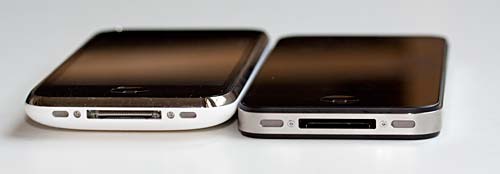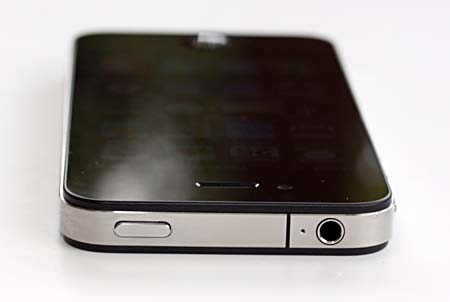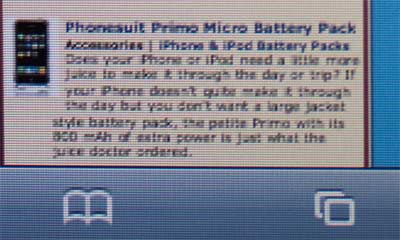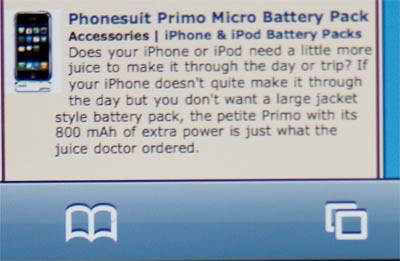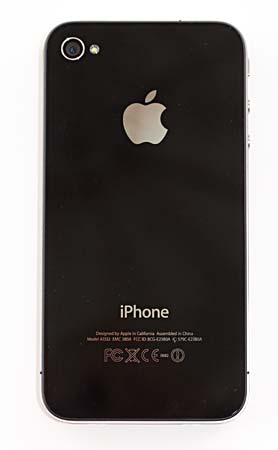
|
||||||||
The Retina Display, which packs 4 times more pixels into a 3.5" touch screen than the previous gen iPhone's, is indeed sharp. Whether you have young and keen eyes or old and presbiopic eyes, you'll see the difference if an old gen and iPhone 4 are placed side by side. Amazon has already updated their Kindle application to take advantage of the Retina Display and fonts are smooth enough for an amoeba to slide down the slope of the letter s. Despite the much higher 960 x 640 pixel resolution vs. the old 320 x 480, you won't see more stuff on screen. This is something akin to pixel-doubling where icons, text and other UI elements are scaled up, because it would be incredibly difficult to read on a screen that small running at such a high resolution, even with 326 ppi (pixels per inch) of clarity. Example: the Sony Vaio P 8" notebook running at 1600 x 768 resolution (with something around 210 ppi density) is incredibly sharp but hard on the eyes nonetheless.
100% crop macro shots of the iPhone 3GS display (left) and the iPhone 4 in Safari. Seeing is believing. OK, so the iPhone 4 looks great from the casing to the display. How about call quality? Do any of you still make calls, or are threaded messaging and social networking (with background multi-tasking apps in the works for iOS 4) enough for you? Some reviewers have stated that call quality is much better than previous generation iPhones, despite the often lower signal bars and troublesome antenna design. Sorry to say, but our iPhone's call quality is no better than the 3GS. Despite the new tower tuning method that looks for the tower with the least congestion (even if it means fewer bars), our iPhone 4 garbles outgoing words a bit when the signal is at 33% or lower according to signal bars (Apple has removed the old code that showed you signal in the industry standard -db). Incoming audio is on the other hand much improved and volume is good. The iPhone 4 is a relative rarity: it's not just quad band GSM (that's common), it's quad band 3G HSDPA. That means 3G will work in the US on AT&T, in Canada, Europe and Asia where GSM networks with 3G are available. It will not work on T-Mobile's US 3G network however.
Facetime Our iPhone game and accessory reviewer Thomas Slayton reports on Facetime: As I lounged on the couch, I surprised my wife in the next room with her first “Facetime” call. For those of you who are unfamiliar with Facetime, it’s video chat over WiFi made easy. You can send video from your choice of front or rear camera. The iPhone 4 wasn’t the first to offer this feature, but Apple certainly has taken what was arguably a toy for techies and brought it to the mainstream. I say this because I could never see my mother drilling down into a video chat app to tweak settings and build a friends list. However, I sure as heck could see her pressing the large, friendly Facetime button. In short; this works as advertised. As long as you have a WiFi connection, you can engage in a video chat with other iPhone 4 owners. I certainly wouldn’t use it to call my boss but for friends and family, it’s solid gold. Camera Marketing tells us that lots of megapixels is a good thing. Our eyes tell us that it isn't so. We've seen some 5 and 8 megapixel smartphone cameras that just plain depress us. And Apple is the undisputed king of marketing, so when Steve Jobs told us the iPhone 4's camera was the bee's knees, we took it with a grain of silicon. Happily, Steve was telling the truth, and the iPhone 4 not only beats the mediocre iPhone 3GS for still image quality, it's among the best 5 megapixel shooters. In fact, it takes better photos than the HTC EVO 4G and its 8 megapixel shooter. Here are two sample photos, with a 100% crop of each:
Video quality on the 3GS was pretty good, at least relative to its photo quality. The iPhone 4 takes 720p video at a natural 30fps that's good enough to leave an older generation Flip Video at home. It's not as good as Nokia Nseries smartphones, at least not those made in the past 2 years, but it's better than most camera phones on the market. We did note a tendency to overexpose, which you'll see in our sample video. That video was shot indoors on a cloudy day-- we'd understand if we were outside in bright sunlight but that wasn't the case here. Given the light loving sensor, videos shot in less bright locations actually look better. Recorded volume was too low in our tests.
The nearly featureless camera application gains a few features: zoom and selectable focus points. Tap on the viewfinder to select the focus point and bring up the digital zoom bar. Unlike most camera phones, you can shoot in portrait mode as well as landscape. Video file sizes are surprisingly small, our sample video is 40 seconds and 53 megs. After the camera has saved the video, you can email it, send it via MMS or upload it to YouTube. The recorded video format is 1280 x 720 resolution, MPEG 4 MOV /H.264 format with AAC mono audio. Since iOS 4 has user selectable wallpapers, you can use camera images as wallpaper.
Conclusion Continuing reception issues aside, the iPhone 4 is the best iPhone yet, and it's still one of the best smartphones on the market. After 4 years, the competition is catching up though, and we've seen this before with Apple. I started life as an engineer working on Apple peripherals back when Steve Jobs had yet to leave Apple, and over the course of years I've seen truly innovative products come out of Apple that were by far better than anything else on the market. But other manufacturers manage over time to copy and improve their own products, and Apple's lead diminishes. Apple is great at new products that set the tech world on its ear, but they're not so great at revising those products to maintain that clear lead. Not that the iPhone 4 isn't beautiful, incredibly fun and so easy to use that a non-techie grandma could come up to speed in 20 minutes. It is all those things, and Facetime is particularly ingenious because it's so easy to use and it doesn't require any additional plan features or charges. But right now, it's marketing and the incredible App Store that keep the iPhone at the front of the pack. There are other smartphones that have better and more rugged hardware (faster CPUs, larger displays, expandable storage, higher resolution cameras) and a more open app market. They've copied the multi-touch capacitive display, focused on ease of use, true robust multi-tasking and started their own (still smaller) app markets, particularly Android. The Motorola Droid X, HTC EVO 4G on Sprint and the HTC Incredible are strong contenders. Even the aging Palm Pre Plus, thanks to its extreme pocketability, hardware keyboard and innovative, super-friendly OS with more elegant multi-tasking has something to offer against the iPhone. If you're an iPhone person, by all means get the iPhone 4. If you're an AT&T customer who enjoys AT&T service, then get the iPhone 4. But if you're not happy with AT&T, remember that their iPhone exclusive ends next year (2011), and you'll probably be able to get the next iPhone on another US carrier. And AT&T's ETF for the iPhone 4 is $325, so you won't be able to leave AT&T until June 2012 at the soonest (assuming you got the phone the week it launched) without coughing up some dough.
Websites: www.apple.com, wireless.att.com Price: $199 for the 16 gig model and $299 with the 32 gig. These prices are with a 2 year contract, and note that AT&T has a higher ETF (early termination fee) of $325 if you end your contract early.
| ||||||||

